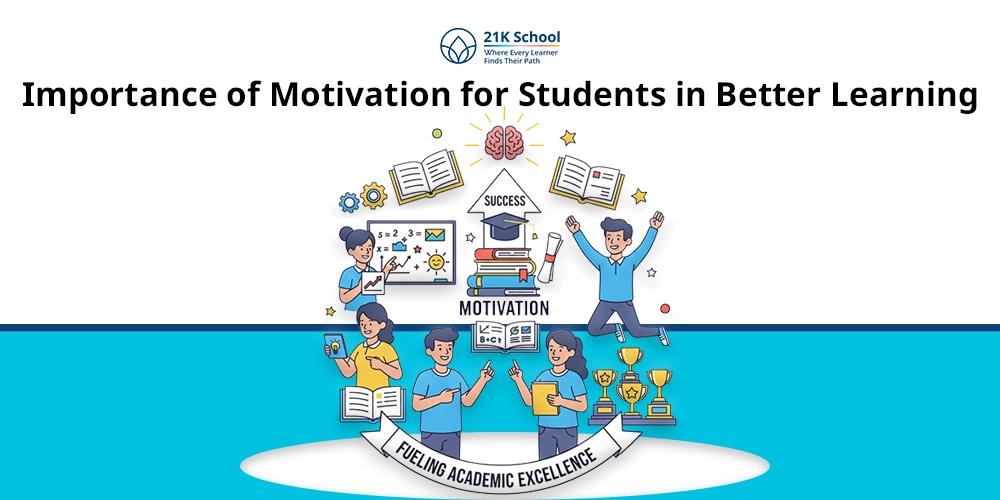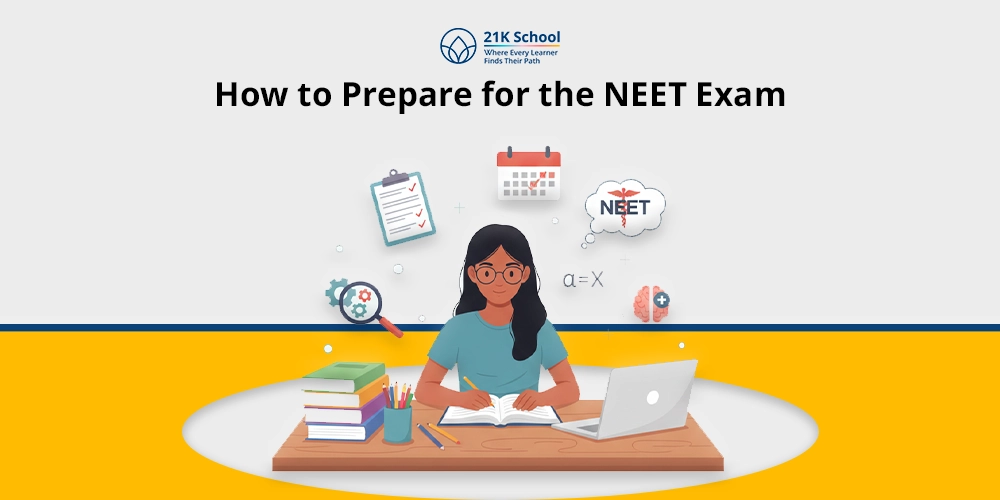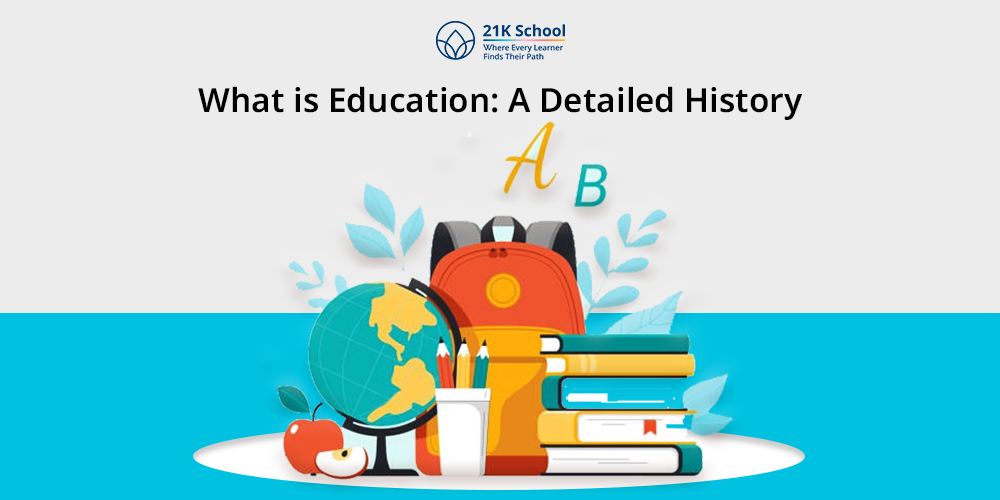
Do you know the real meaning of education?
Education is the process of transmitting and gaining knowledge in a structured environment known as Education. The term education is a broad term that is used to define the process of acquiring skills, values, learnings, ethics, knowledge and so on.
The education system has three main characteristics traits such as formal, non-formal and informal.
Formal education occurs within a structured learning environment, non-formal education contains structured learning but occurs outside the formal classroom, whereas informal education can be learned through daily experiences.
With time, the definition of education has changed a lot. Various philosophers and educationists have defined education as a whole process of teaching and learning in schools.
Early childhood education, primary education, and secondary education are the three stages into which formal and informal education are divided.
Children are socialised into society through education, which gives them the skills they need to contribute to society and instils cultural values and norms. Education plays an integral role in economic development and promotes literacy rates.
Table of Contents
What is Education?
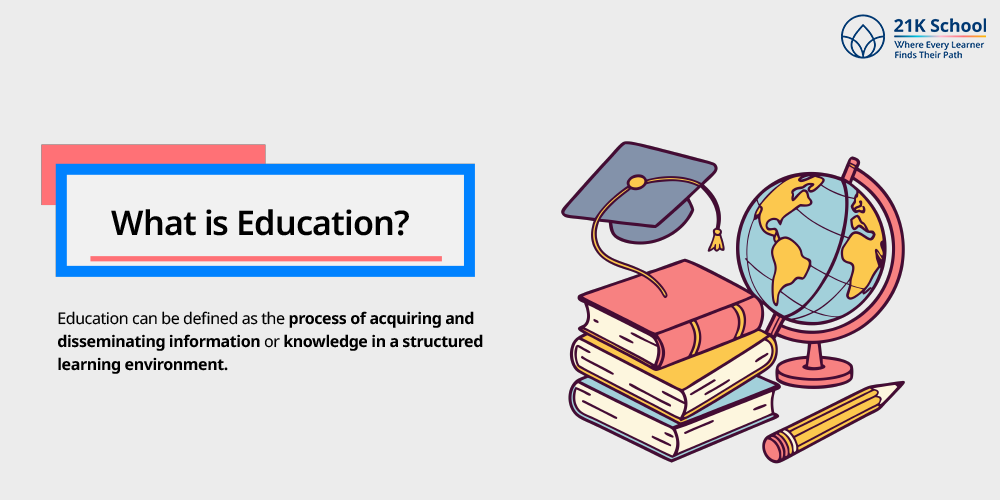
Education can be defined as the process of acquiring and disseminating information or knowledge in a structured learning environment.
Education is a broad term which encompasses every aspect of the teaching and learning process that can be conducted in a group or individually. Education contains formal, non-formal and informal methods, every method has different educational aspects.
Formal and informal education are separated into three stages: early childhood education, primary education and secondary education. However, education doesn’t have any specific definition, and it changes with time and considerations.
The main aim of education is knowledge acquisition, which gives individuals information and insight into a range of topics such as Science, Math, Literature and Social studies.
Education also emphasises skill development, giving students transferable skills like technical skills, communication skills, problem-solving skills, and critical thinking.
History of Education
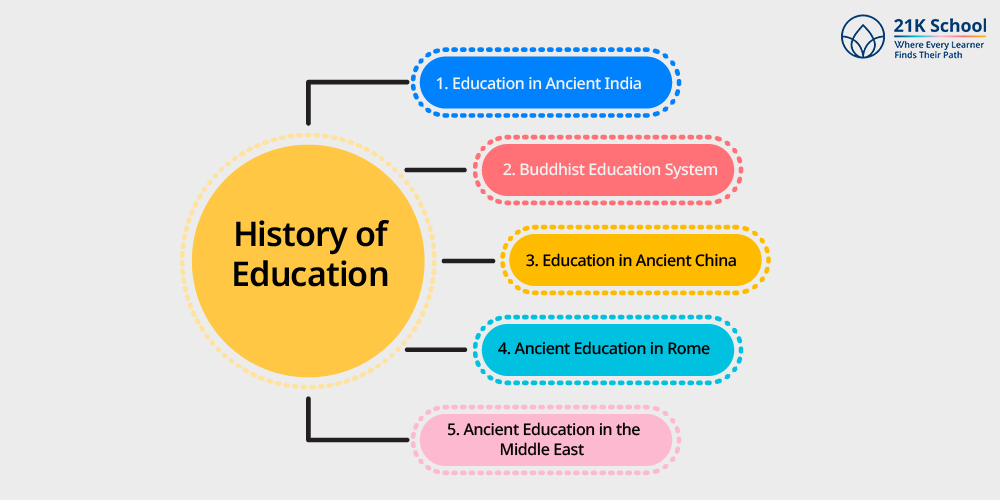
Education has a very vast history that goes back to ancient civilisations. Under the leadership of the Middle Kingdom of Egypt, the first formal school in history was put into existence by Kheti Mentuhotep II treasurer, in 2061–2010 BC.
In ancient India, Vedic and Buddhist learning systems were the primary means of education. On the other hand, in ancient China, the Xia dynasty, 2076–1600 BC, established the first educational system.
Islam reached China and Spain in the seventh and nineteenth centuries. Later on, Muslims began a schooling system in the city of Saudi Arabia known as Medina in 622. Earlier, the classes were held in mosques; later on, separate schools were created.
After that modern education system was introduced by the Europeans, which emphasised modern education and mass schooling. Founded in 1160, the University of Paris was the first Christian university.
By the year 1800, mass education had been implemented in Prussia in an effort to produce more soldiers and more obedient citizens. A compulsory education was established by Vladimir Lenin in 1919, with the main aim was to remove illiteracy.
1. Education in Ancient India
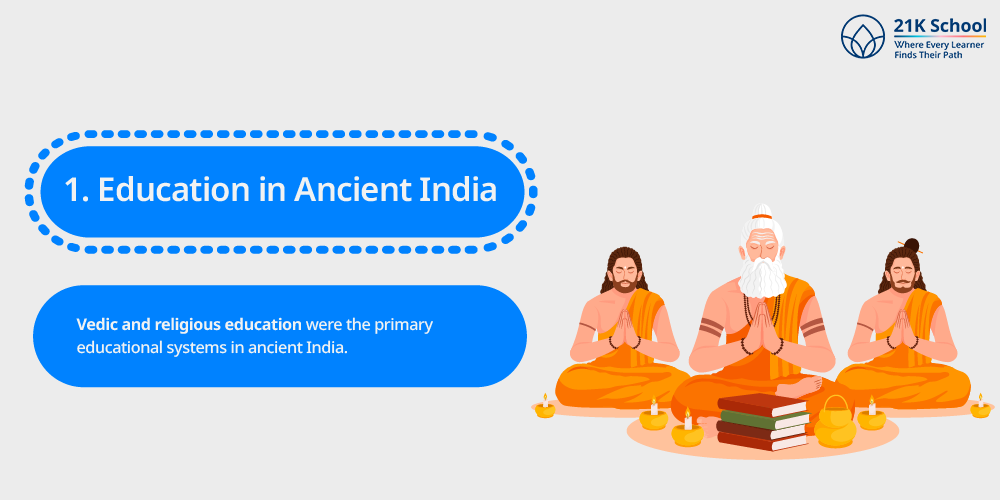
In ancient civilization education has seen significant changes over the years. Vedic and religious education were the primary educational systems in ancient India. In ancient India, the main objective of education is to develop character and self-control among individuals.
In ancient India, religious knowledge was transmitted orally rather than in writing. Earlier, there were three steps in the education process known as Shravana, Manana, and Nididhyasana.
In the Indo-Aryan civilisation of northern India, Sanskrit education was based on the Vedic studies and later on Sanskrit texts and scriptures were introduced for a period of 600 BC to 1500 BC.
Later on, the Gurukul system was introduced, in which students lived with their teachers for a long time. They used to study a variety of subjects during that time, including language, morals, values, philosophy and mathematics.
2. Buddhist Education System
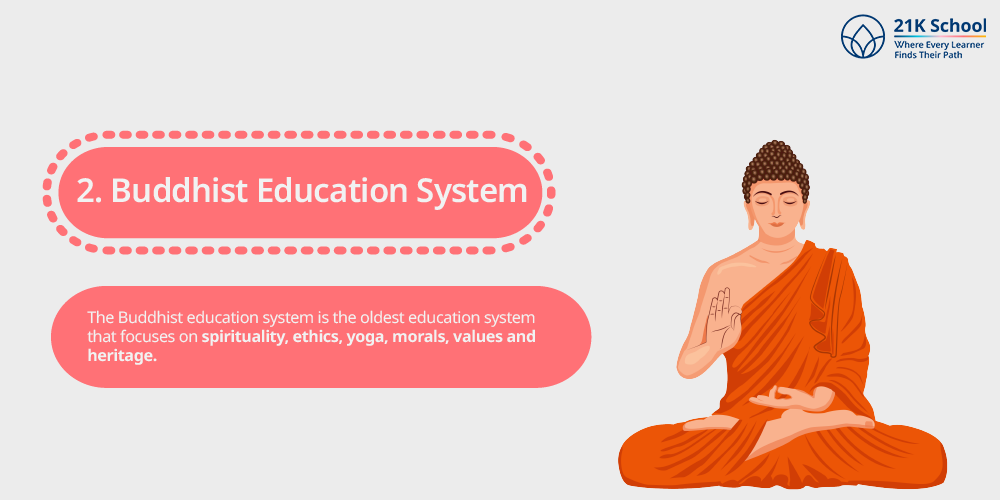
The Buddhist education system is the oldest education system that focuses on spirituality, ethics, yoga, morals, values and heritage. Pitakas are included in the Buddhist educational system and are the subjects of the early education system.
These Pitakas include Vinaya Pitaka, Sutta Pitaka, and Abhidhamma Pitaka. Nalanda was a famous Buddhist monastery in the kingdom of Magadha.
3. Education in Ancient China
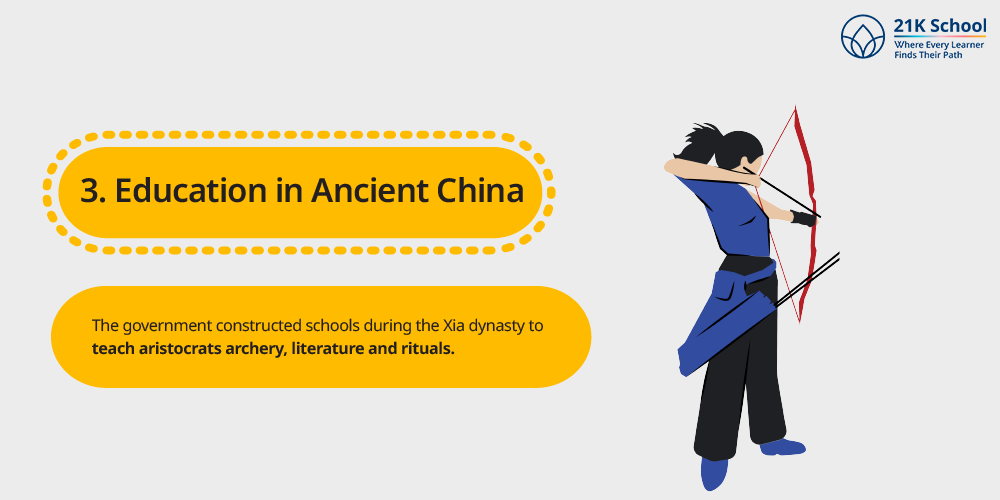
The first educational system in China was created during the Xia dynasty in 2076–1600 BC. The government constructed schools during the Xia dynasty to teach aristocrats archery, literature and rituals.
During the Shang dynasty between 1600 BC to 1046 BC, aristocrats’ children studied in government schools. In the Zhou dynasty 1045 BC to 256 BC, five national schools and 4 aristocratic schools were established.
Later from 246 BC to 207 BC Qin Dynasty established a central control over the outer areas, which focused on creating a hierarchy for literacy and knowledge.
In the Han dynasty, male children were considered ready to begin learning the fundamentals of reading, writing and mathematics by the age of seven. The academy had more than 30000 boys between the ages of fourteen and seventeen by the end of the Han dynasty in 220 AD.
4. Ancient Education in Rome

In Ancient Rome, the first school was established in the 4th century. The main focus of the education system was focused on fundamental socialisation and elementary schooling.
During the Roman Empire, the Roman education system was established in which both boys and girls were educated, but not together; instead, they conducted different classes separately. After implementing the Roman Education system in the 2nd century, it was seen that the literacy rate had grown to 20% from 10%.
5. Ancient Education in the Middle East
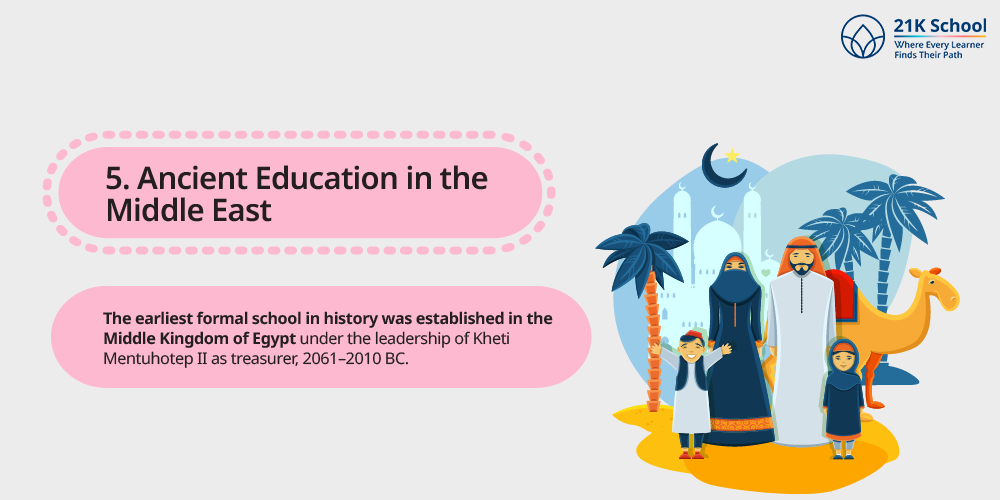
The earliest formal school in history was established in the Middle Kingdom of Egypt under the leadership of Kheti Mentuhotep II as treasurer, 2061–2010 BC.
However, at that time education was limited only to the sons of the rich and professionals, such as scribes, physicians, and temple administrators; none other than were allowed.
During 2000 to 1600 BCE literacy was disseminated through the interconnected learning across the entire civilisation.
Education in the Middle Ages
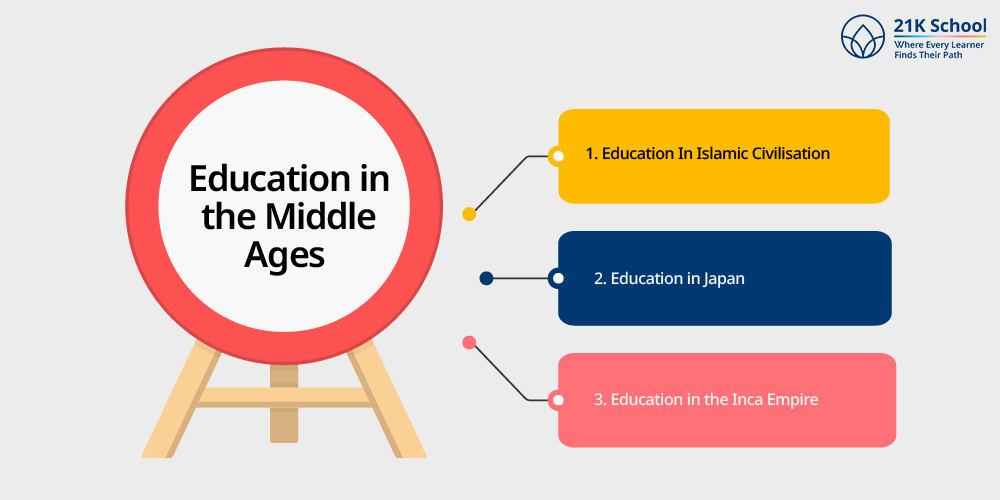
In the Middle Ages the education system took a turn, as education started in the church, monastery and town hall. In the late medieval era, students typically between seven to fourteen started attending town schools.
Boys attending these schools received instruction in reading to more complex Latin language instruction. everything from the fundamentals of
Many medieval universities were operated for hundreds of years as Christian monastic schools where monks taught classes before being formally established as cathedral schools.
Numerous universities were founded in Italy, France and England in the late 11th and 12th centuries, offering courses in the arts, law, medicine and theology.
1. Education In Islamic Civilisation
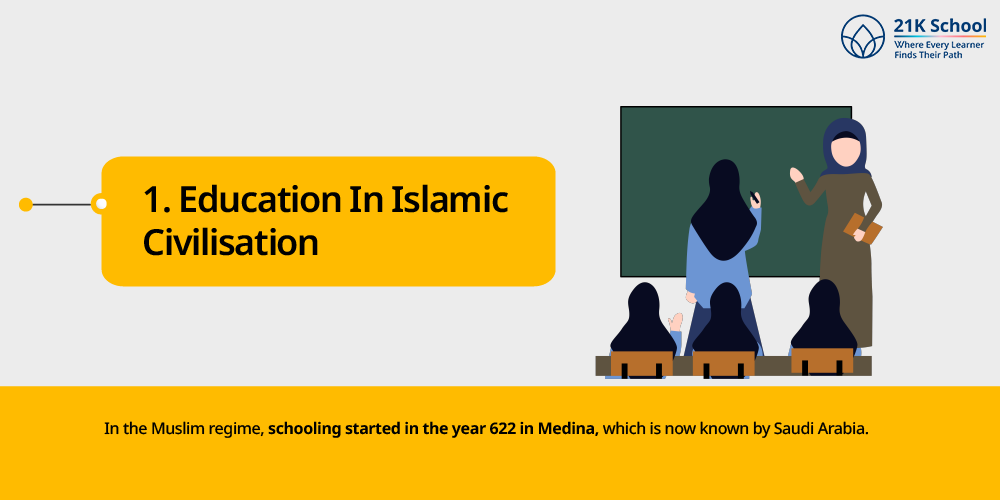
In the Muslim regime, schooling started in the year 622 in Medina, which is now known by Saudi Arabia. The Nizamiyah school, the first independent school, was founded in Baghdad in 1066. During that time, children as young as six were eligible for free tuition.
The Quran encourages Muslims to seek education, and societies started implementing education and schooling. In 975, Al-Azhar University was founded in Egypt, offering Islamic studies and degrees in the fields of medicine, law, jurisprudence, grammar, and astronomy.
During the early period Quran was taught in Arabic at the Islamic mosque school known as Madrasah, which was completely different from the universities of medieval Europe.
During the 15th and 16th centuries, students from the Middle East came to study in the Islamic capital of Timbuktu in the West African country.
2. Education in Japan
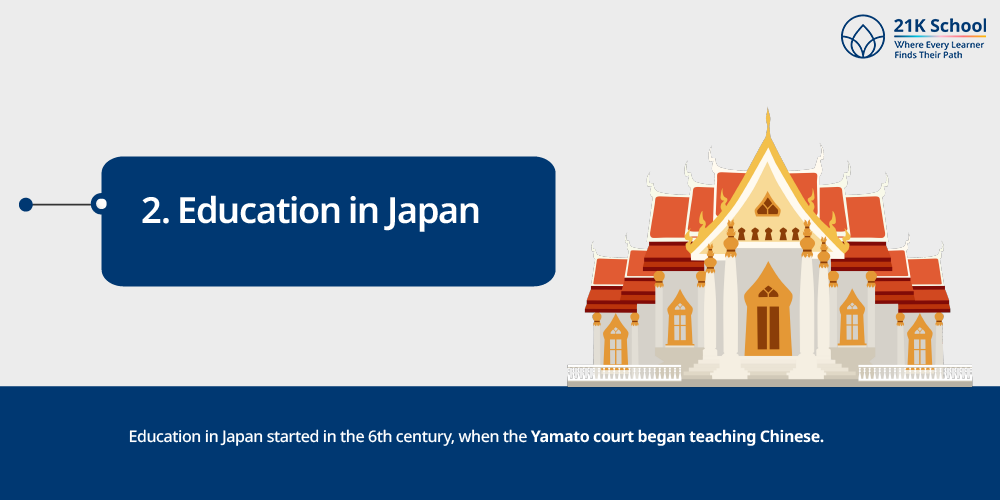
Education in Japan started in the 6th century, when the Yamato court began teaching Chinese. Foreign cultures have frequently contributed fresh concepts to the evolution of Japanese culture. By the 9th century, Japan had established higher learning institutions.
In the medieval era Zen Buddhist monasteries were particularly significant educational institutions during the and the Ashikaga School, also known as Ashikaga Gakko, was a thriving center of higher learning in the 15th century.
3. Education in the Inca Empire

During the Inca Empire, two primary areas of focus were introduced in the 15th and 16th centuries, which were known as Inca education. However, at that time, education was divided between the general public and education for the upper classes.
They included prominent priests, poets and philosophers who preserved the Incas’ oral histories by teaching the kingdom about their history, culture, customs and traditions.
The majority of people in the Inca territories did not receive the same formal education as royalty, which was a socially discriminatory practice.
Education in the Modern World
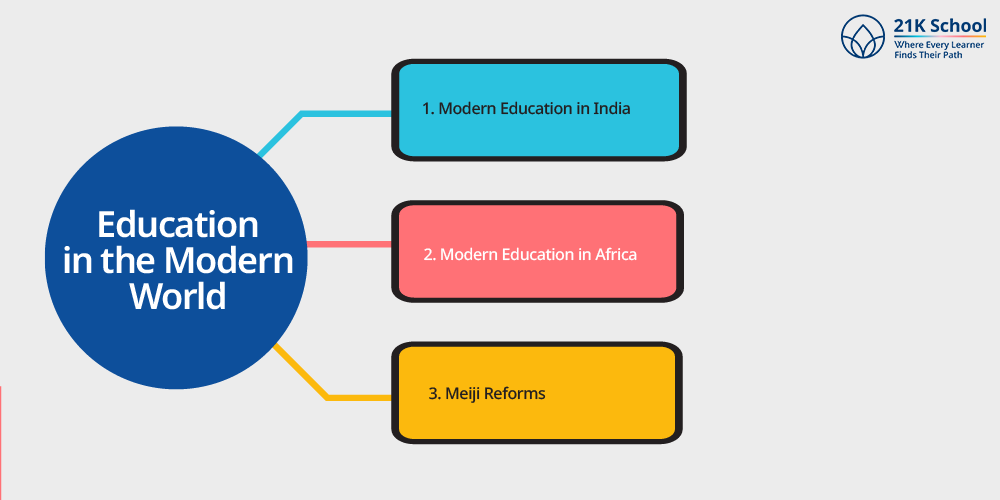
In the modern world, education has become compulsory for every country. European educational systems today have their roots in the schools of the High Middle Ages. Most schools in the modern era follow the European system of formal education.
In the modern world, most Western Central and some Eastern European countries started offering numeracy literature and language instruction in the late 19th century, in part because politicians thought that education was necessary for disciplined political conduct.
In the 17th century, John Amos Comenius, an educator and scientist, established a revised universal education system in Central Europe that became popular throughout the continent.
According to Article 26 of the 1948 Universal Declaration of Human Rights, every student has the equal right to education. It states that education must be free and compulsory till elementary education.
1. Modern Education in India
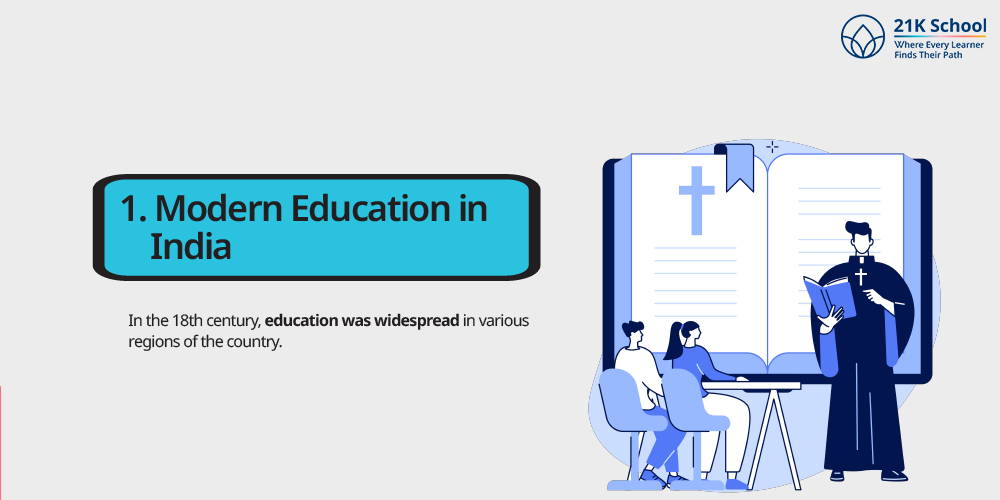
In the 18th century, education was widespread in various regions of the country. At that time, mostly mathematics, medicine, theology, law, astronomy, writing, arithmetic, and literature were taught.
The current education system of India follows a Western-style education, which was introduced by the Britishers by Lord Macaulay. During the British regime, Lord Macauley also emphasised the English language as a medium of instruction.
Lord Curzon, who served as Viceroy from 1899 to 1905, prioritised mass education after learning that only 20% of Indian children were enrolled in school. His reforms were mostly focused on reorganising university systems and literacy training.
After that, various governmental reforms were taken to make education equally accessible to every individual. After the RTE Act, NEP and NCF were established to have proper control over education with an emphasis on providing equal education to all.
2. Modern Education in Africa
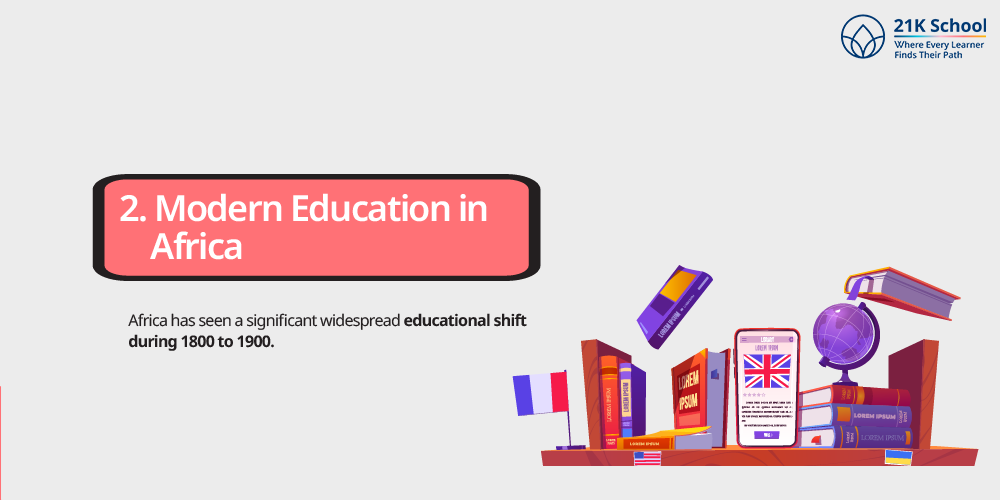
Africa has seen a significant widespread educational shift during 1800 to 1900. In the 1880s, Africa adopted the French education system, as earlier it had been controlled by France.
In 1903, the French curriculum served as the foundation for adapted education, which replaced French-specific content with analogous material taken from the African context.
However, in the early 2000s, the enrollment rate of students to primary schools was only 58%, and according to the USAID Centre, 40% of children haven’t received primary education.
However, after various reforms and governmental rules, access to education has become compulsory and simpler.
3. Meiji Reforms
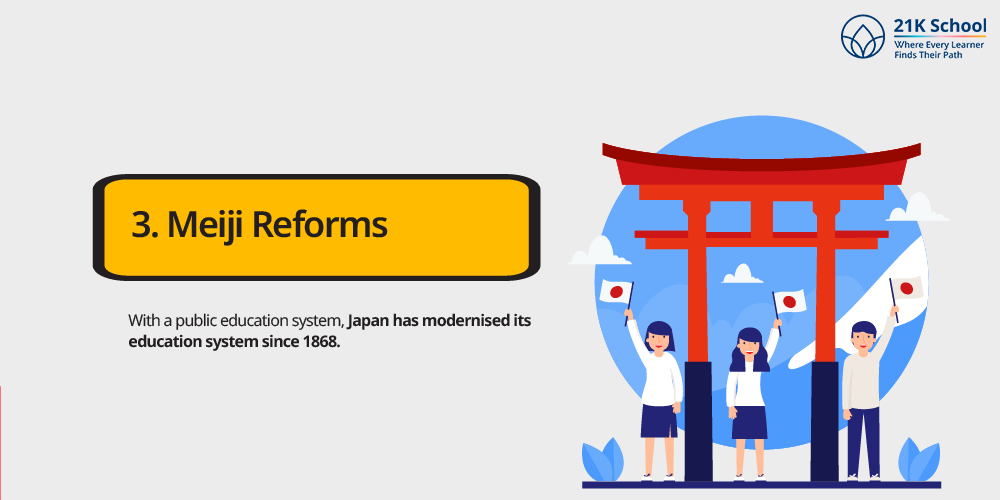
With a public education system, Japan has modernised its education system since 1868. To research the educational systems of prominent Western nations, missions such as the Iwakura mission were dispatched overseas.
In order to accomplish that, the Western-style school became the agent. Schools were creating new perspectives on childhood by the 1890s.
By 1900 over 90% of school-age children were enrolled in elementary schools up from roughly 40% or 50% in the 1870s, despite widespread public opposition, particularly to school fees.
Types of Education
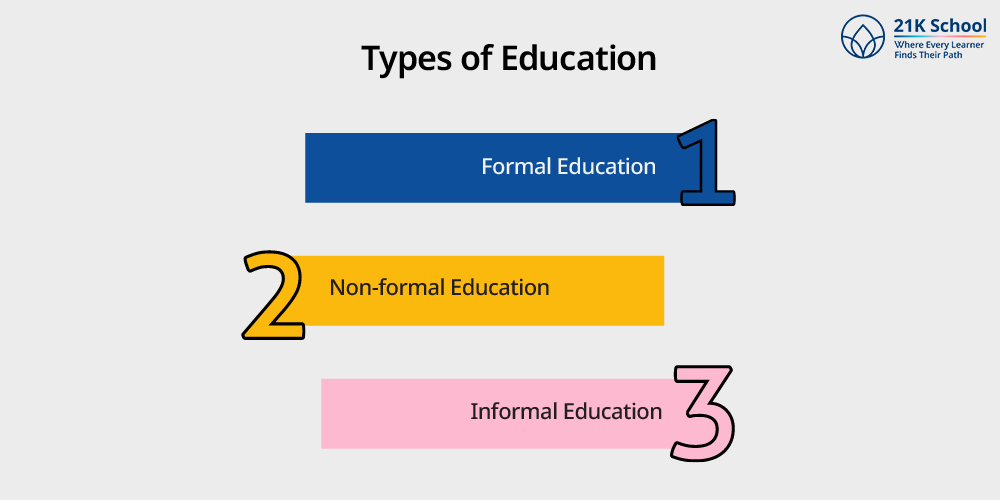
The education system has mainly 3 types that emphasise structured and unstructured learning environments. Education is essential in shaping the thinking and learning process. Education is not a one-room and can be acquired through real-life experiences as well.
The Indian education system has a formal, non-formal and informal type of education. Every type has a different learning style and art of instruction. The following are the types of education
1. Formal Education
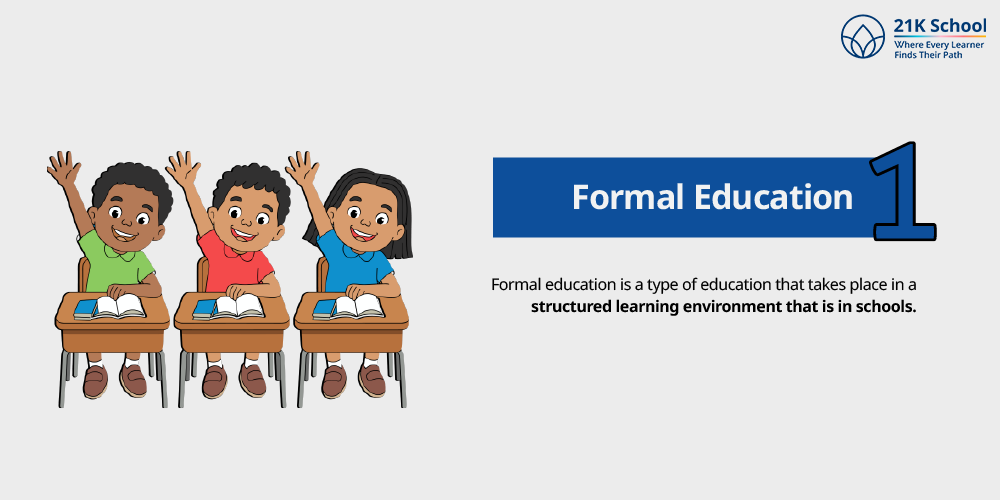
Formal education is a type of education that takes place in a structured learning environment that is in schools. In formal education, students learn from their schools and engage in teaching and learning processes.
In formal education, teachers are the sole representatives of transmitting knowledge to students. Formal education continues from elementary school to secondary school, and both the teacher and the student participate in the educational process.
2. Non-formal Education
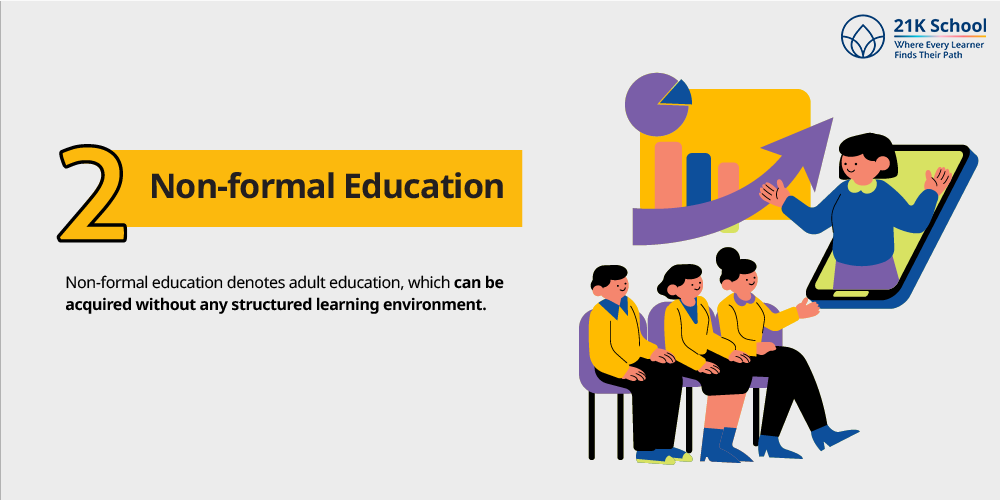
In non-formal education, students acquire a deep form of understanding. Non-formal education denotes adult education, which can be acquired without any structured learning environment.
Non-formal education is flexible and provides multiple activities in competence with adult education, skill development programs, community education and free education.
Non-formal education contains many forms of instruction which help individuals to develop certain skills or abilities through adult literacy and community engagement.
3. Informal Education
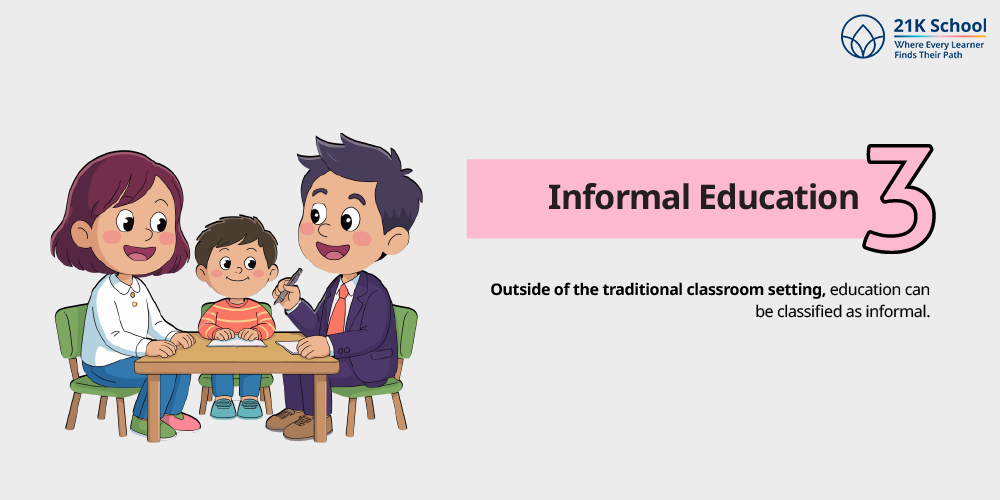
Outside of the traditional classroom setting, education can be classified as informal. In this type of education, parents and tutors teach the children. People can also acquire informal education with the help of books and virtual learning platforms.
An individual gains this experience through consistent practice and by watching others. Informal education allows students to develop personality traits and logical thinking skills.
Stages of Education

The Indian education system comprises five stages that contain a structured formal education. Higher secondary education, primary education, secondary education, pre-primary education, and higher education are the stages of education.
The curriculum varies by stage according to the children’s aptitude and comprehension level, which includes value education. Below is a comprehensive overview of the Indian education system’s current structure.
1. Pre-primary Education

Pre-primary education includes early childhood education for children ages three to six. Pre-primary education includes kindergarten, preschool, anganwadi and balvatika.
The main objective of pre-primary education is to promote overall development among children. Also, the main focus of online preschool is laid on the cognitive development of children’s problem-solving skills.
2. Primary Education
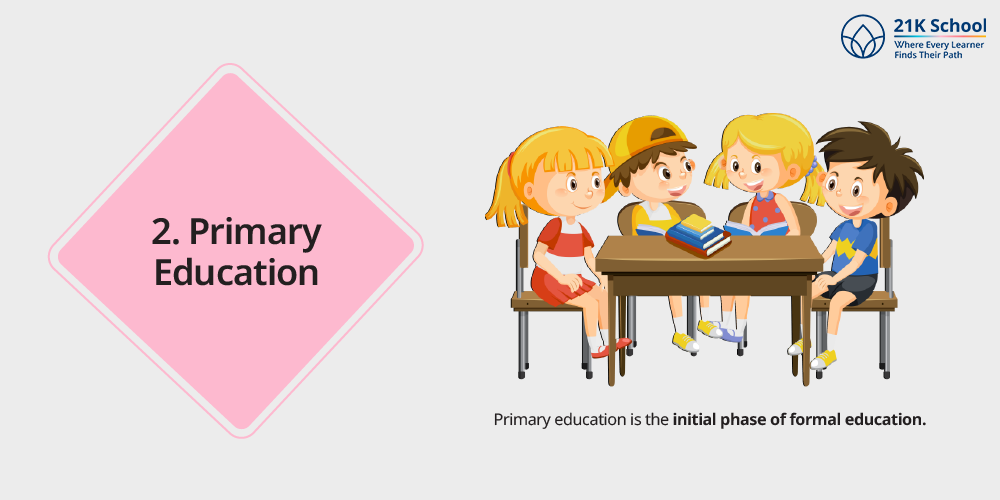
Primary education is the initial phase of formal education. Primary education will be provided to children aged 6 to 11 in order to strengthen their foundation and acquire the necessary skills.
Hence, many online primary schools emphasis on English numeracy, critical thinking and language as their main areas of emphasis.
3. Secondary Education
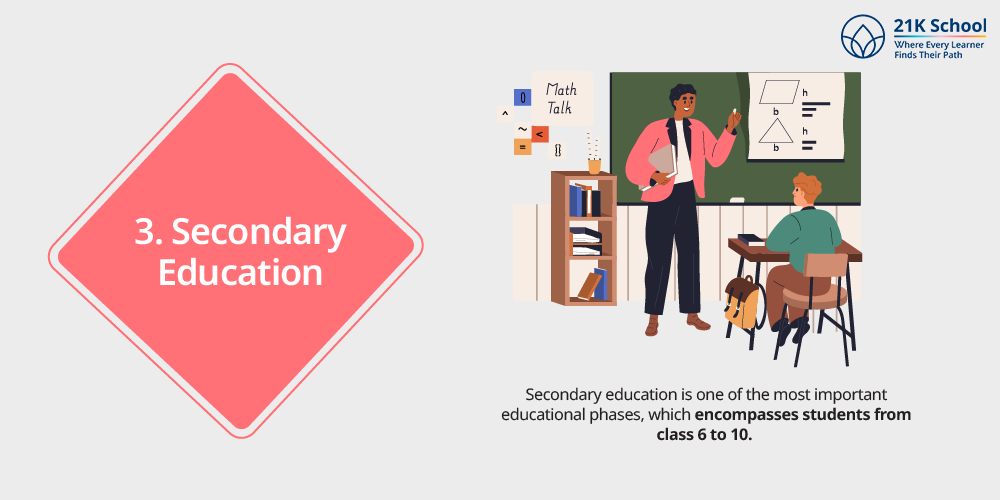
Secondary education is one of the most important educational phases, which encompasses students from class 6 to 10.
The primary goals of secondary education is to solidify the academic foundation and the development of analytical skills, problem-solving skills, and critical thinking skills.
Hence, leading online high schools offer English, language, mathematics, science, social science, and vocational studies as required courses.
4. Higher Secondary Education
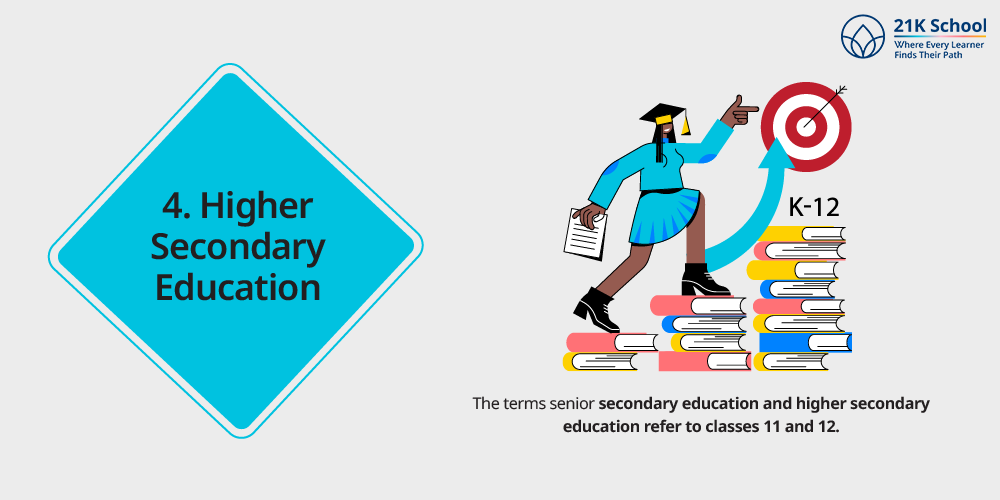
The terms senior secondary education and higher secondary education refer to classes 11 and 12. Students in higher secondary school are free to select the subjects and streams that best suit their interests.
Students can select from streams like science, arts and commerce in senior secondary education. The 12th board exam is one of the most significant tests that all students take at the end of their academic year. Students can pursue further education after passing the exam.
5. Higher Education
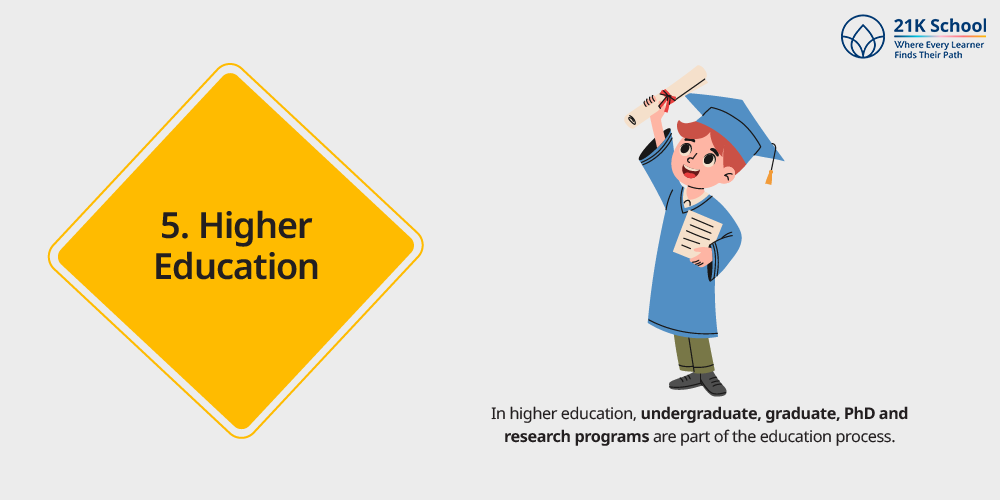
In higher education, undergraduate, graduate, PhD and research programs are part of the education process. Based on their scores from their 12th boards, candidates can be admitted to a variety of colleges, universities and other institutions.
Students have access to a broad range of courses in a number of fields, including science, medicine, law, management and the arts. Undergraduate programs in India normally last three to four years, while postgraduate programs last one to five years.
Challenges of Education
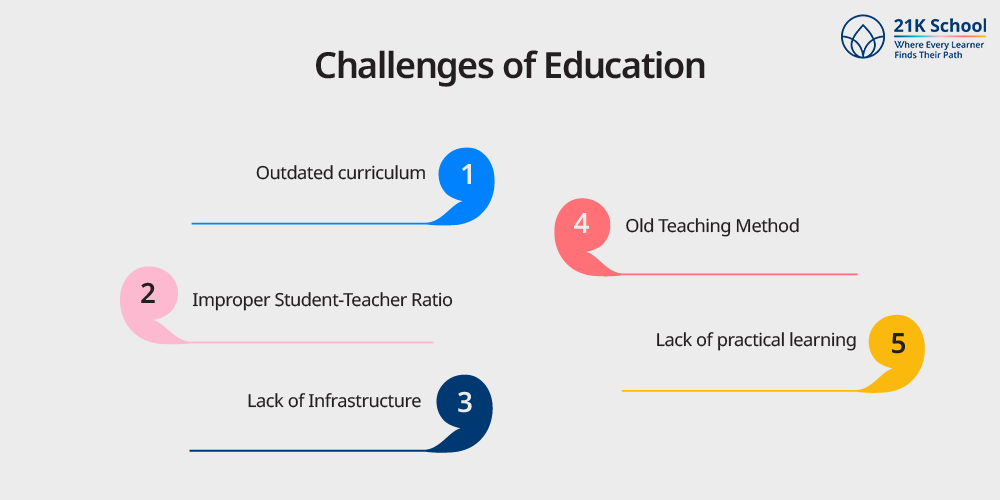
Education is very essential for the holistic development of children. Education provides students with foundational skills and allows them to develop their cognitive skills.
However, along with so many benefits, the Indian education system still faces so many challenges that hinder its true potential. Here are the problems of the Indian education system that create hindrances in the Indian Education System.
1. Outdated curriculum
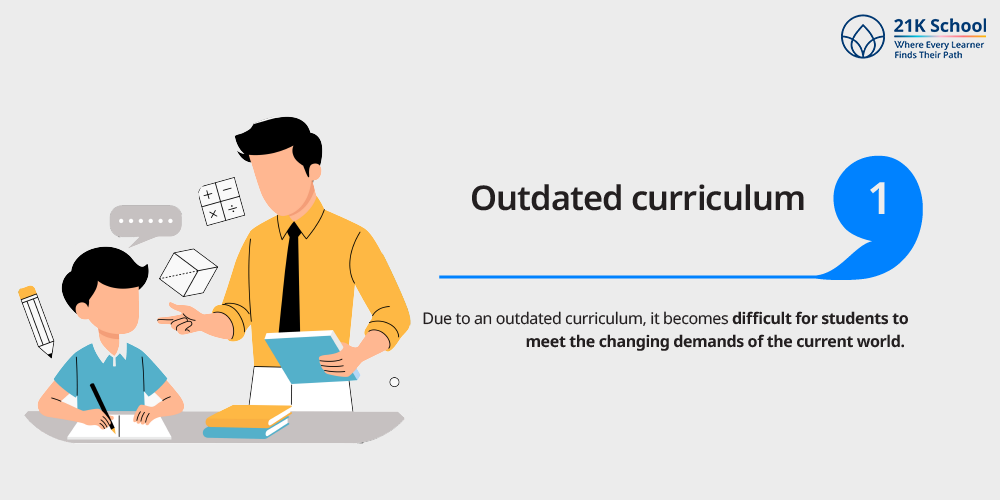
In the Indian education system, old traditional teaching and learning methods are used. Due to an outdated curriculum, it becomes difficult for students to meet the changing demands of the current world.
Due to outdated and traditional learning approaches it becomes tough for students to acquire the necessary job skills in the market.
Solution to Tackle the Problem of Outdated Curriculum
The problem of outdated curriculum can be mitigated by introducing new curriculum and learning approaches.
Updating the curriculum with the latest trends and technical aspects allows students to engage in the teaching and learning process.
2. Improper Student-Teacher Ratio
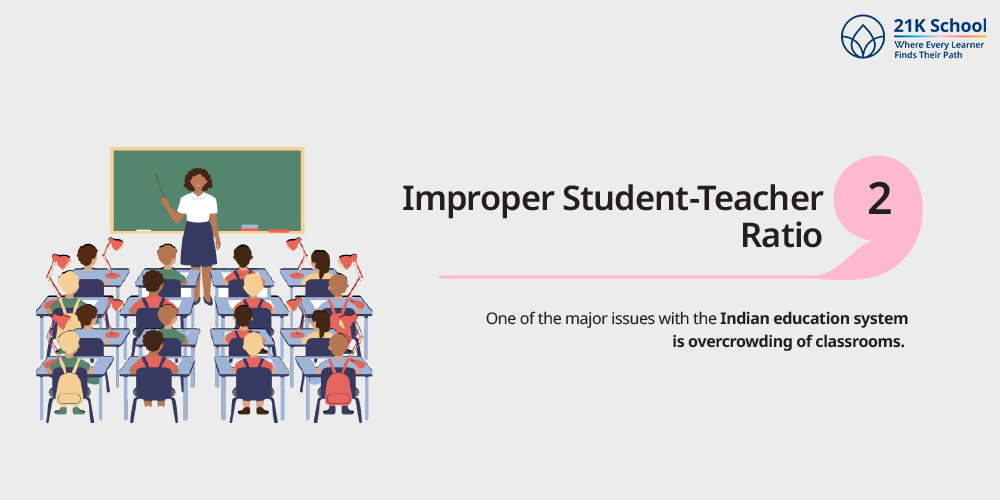
One of the major issues with the Indian education system is overcrowding of classrooms. We can say that 1 teacher for 30 to 40 students negatively affects students’ learning as well as creates issues for the teacher.
Due to this, it becomes difficult for students to grasp concepts more easily and clear their doubts.
Solution for Improper Teacher-Student Ratio
The problem of improper teacher-student ratio can be overcome by effective utilisation of classes and breaking them into small groups.
Making classes small and one-to-one sessions allows students to develop confidence and attention. This also helps teachers to conduct the classes more efficiently and enhances teacher student relationship.
3. Lack of Infrastructure

Lack of infrastructure is a major issue in the Indian education system because of inadequate funding. Schools and other institutions lack adequate infrastructure and other educational resources due to a lack of budget.
Additionally, the cost of higher education prevents many students from low-income families from pursuing degrees. Due to this, many students dropout of school.
Solution for the issue of Lack of Infrastructure
The issue of lack of infrastructure can be overcome by effective utilisation of funding and proper allocation of budgets.
Reducing the cost of higher education will boost enrollment and motivation. Affordable fees allow students to be able to pursue their dream careers.
4. Old Teaching Method
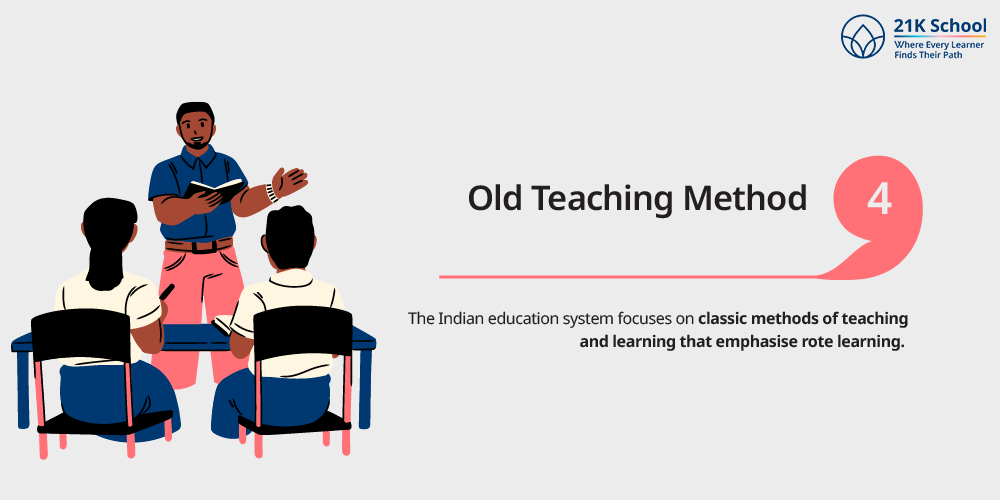
Another main disadvantage of the Indian education system is that it uses old teaching methods. The Indian education system focuses on classic methods of teaching and learning that emphasise rote learning.
The education system is a teacher-centred method in which teachers are the sole representatives for imparting education and knowledge. This classical method reduces students’ engagement and reduces their class participation.
Solutions for the Old Teaching Method
The problem of old teaching methods can be avoided by using innovative teaching methods and strategies that will combat students’ boredom and encourage participation in class.
Through using technology and AI in the classrooms, students will participate in the teaching and learning process.
5. Lack of practical learning
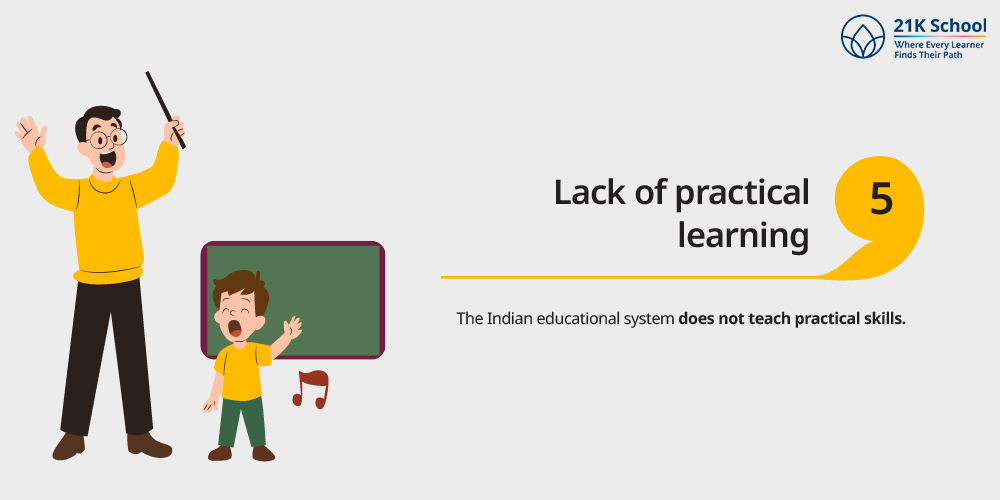
The Indian educational system does not teach practical skills. The Indian education system’s only emphasis was on theoretical learning, which entails reading and memorising.
Students who lack practical skills find it difficult to grow and overcome obstacles in real life. This also hinders their career opportunities to grab future jobs.
Solution for Practical Learning
Providing students with practical skills rather than theoretical aspects allows students to develop practical skills and participate in class activities.
Including extracurricular activities and project work allows students to enhance their academic performance and enhance their career opportunities.
Learn about top 15 benefits of education.
Final Note
Education is a complex process that is essential to the development of both people and societies. Formal, non-formal and informal education are among its many forms, all of which support people’s overall development.
The significance of education has been revealed throughout history, underscoring the necessity of modifying educational systems to satisfy modern demands.
Even with the advancements problems like out-of-date curricula, unfair student-teacher ratios, inadequate infrastructure, dependence on conventional teaching techniques and a lack of hands-on learning still exist especially in India.
In order to keep education current and effective in preparing people for the complexity of modern life, these issues must be addressed through creative solutions like online middle schools and reforms.
In the end, a strong educational system is essential for producing knowledgeable, capable and accountable individuals who can advance economic growth and make constructive contributions to society.

